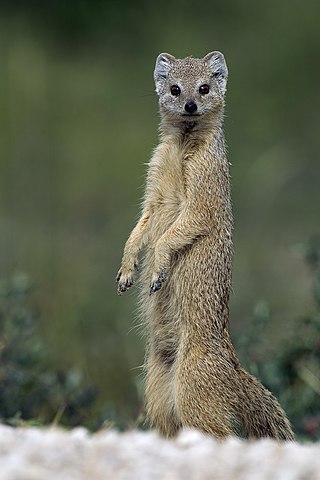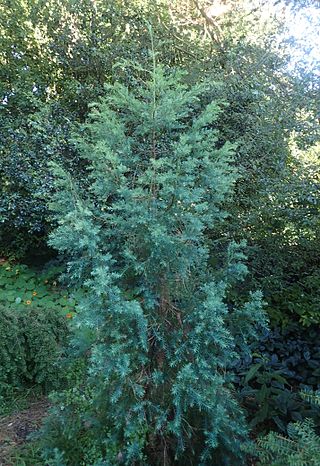
The mountain zebra is a zebra species in the family Equidae, native to southwestern Africa. There are two subspecies, the Cape mountain zebra found in South Africa and Hartmann's mountain zebra found in south-western Angola and Namibia.

The genus Cordylus includes a wide variety of species of small to medium spiny lizards from Africa, collectively called girdle-tailed lizards or girdled lizards. All are diurnal and ovoviviparous. Most species are rupicolous (rock-dwelling), while a few species are arboreal or live in burrows. They defend themselves with osteoderms and by quickly retreating into rock crevices or burrows. Many species live in groups, and males defend territories.

Pseudocordylus is a genus of small to large girdled lizards from South Africa, commonly known as crag lizards. Six species of Pseudocordylus are known; they are distinguished from girdled lizards of the genus Cordylus by the presence of granular scales on the back instead of osteoderms.

The Cape fox, also called the asse, cama fox or the silver-backed fox, is a small species of fox, native to southern Africa. It is also called a South African version of a fennec fox due to its similarly big ears. It is the only "true fox" occurring in sub-Saharan Africa, and it retains primitive characteristics of Vulpes because it diverged early in the evolutionary history of the group.

The hartebeest, also known as kongoni or kaama, is an African antelope. It is the only member of the genus Alcelaphus. Eight subspecies have been described, including two sometimes considered to be independent species. A large antelope, the hartebeest stands just over 1 m at the shoulder, and has a typical head-and-body length of 200 to 250 cm. The weight ranges from 100 to 200 kg. It has a particularly elongated forehead and oddly-shaped horns, a short neck, and pointed ears. Its legs, which often have black markings, are unusually long. The coat is generally short and shiny. Coat colour varies by the subspecies, from the sandy brown of the western hartebeest to the chocolate brown of the Swayne's hartebeest. Both sexes of all subspecies have horns, with those of females being more slender. Horns can reach lengths of 45–70 cm (18–28 in). Apart from its long face, the large chest and the sharply sloping back differentiate the hartebeest from other antelopes. A conspicuous hump over the shoulders is due to the long dorsal processes of the vertebrae in this region.

The yellow mongoose, sometimes referred to as the red meerkat, is a member of the mongoose family. It averages about 0.45 kg (1 lb) in weight and about 510 mm (20 in) in length. It lives in open country, semi-desert scrubland and grasslands in Angola, Botswana, South Africa, Namibia, and Zimbabwe. It is the only species in the genus Cynictis.

Sceloporus grammicus is a species of lizard from Mexico and the southern United States. It is sometimes referred to as the mesquite lizard or graphic spiny lizard.

The white-tailed mongoose is a species in the mongoose family Herpestidae. It is the only member of the genus Ichneumia.

Widdringtonia schwarzii is a species of Widdringtonia native to South Africa, where it is endemic to the Baviaanskloof and Kouga Mountains west of Port Elizabeth in Eastern Cape Province; it occurs on dry rocky slopes and crags at 600–1,200 m altitude. It is threatened by habitat loss, particularly by wildfire. The Willowmore cypress is a protected tree in South Africa.

The cape rain frog or giant rain frog is a species of frog in the family Brevicipitidae. Adults grow up to 45 mm in length. It was the first African frog species to be scientifically described by Carl Linnaeus in 1758, under the name Rana gibbosa. It is the most common and largest of rain frogs. The name "rain frog" that is applied to the genus refers to a belief that these frogs bring rain.
Goggia microlepidota, also known as the small-scaled dwarf leaf-toed gecko, small-scaled leaf-toed gecko, or small-scaled gecko, is a species of lizard in the Gekkonidae family. It is endemic to South Africa.

Lang's crag lizard, also known commonly as Lang's girdled lizard, is a species of lizard in the family Cordylidae. The species is endemic to Southern Africa.
Hemicordylus nebulosus is a species of lizard in the Cordylidae family. It is endemic to South Africa on the mist belt of northern slope of the Hottentots Holland Mountains. The scientific name, H. nebulosus means cloud or dark crag lizard. The name was given due to the melanistic body color. Other names include the dwarf cliff lizard, dwarf crag lizard, dark crag lizard and the cloudy crag lizard.

The Balkan green lizard is a species of lizard in the family Lacertidae. It is the most widespread of the Balkans lizard species. It is found in Albania, Kosovo, Bosnia and Herzegovina, Bulgaria, Croatia, Greece, Montenegro, North Macedonia, Romania, Serbia, Israel, Syria, and Turkey. Its natural habitats are Mediterranean-type shrubby vegetation, sandy shores, arable land, pastureland, plantations, and rural gardens. It is threatened by habitat loss.

Platysaurus broadleyi, also known commonly as the Augrabies flat lizard and Broadley's flat lizard, is a species of lizard in the family Cordylidae. The species is endemic to South Africa.

The common agama, red-headed rock agama or rainbow agama is a species of lizard from the family Agamidae found in most of sub-Saharan Africa. To clear up centuries of historical confusion based on Linnaeus and other authors, Wagner et al. designated a neotype for the species, using a previously described specimen from Cameroon in the collection of the Zoologisches Forschungsmuseum Alexander Koenig in Bonn. The species name was formerly applied to a paraphyletic collection of taxa ; subsequent mitochondrial DNA analysis of various populations indicates they represent separate species. Consequently, three former subspecies A. a. africana, A. a. boensis, and A. a. mucosoensis are now considered separate species, and A. a. savattieri is considered synonymous with A. africana.

The Cape grass lizard, also known as the Cape snake lizard or the highland grass lizard, is a species of lizard in the genus Chamaesaura. It widely found in southern Africa, inhabiting grasslands. In one of the countries it lives in, Eswatini, it is listed as a Near Threatened species.

Cordylus cordylus, the Cape girdled lizard, is a medium-sized lizard indigenous to the southern Cape region of South Africa, where it inhabits crags, rocky outcrops and mountain summits. They evade predators by wedging themselves firmly in rock cracks.

The Cape Cliff Lizard is a lizard species endemic to the Cape Fold Belt of southern South Africa.

Pseudocordylus melanotus, also known as the common crag lizard or Highveld crag lizard, is a species of lizard found in Eswatini, Lesotho, and South Africa. Pseudocordylus subviridis is considered a distinct species by the Reptile Database, but a subspecies of Pseudocordylus melanotus by IUCN.



















